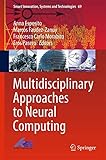Multidisciplinary Approaches to Neural Computing [electronic resource] / edited by Anna Esposito, Marcos Faudez-Zanuy, Francesco Carlo Morabito, Eros Pasero.
Contributor(s): Esposito, Anna [editor.] | Faudez-Zanuy, Marcos [editor.]
| Faudez-Zanuy, Marcos [editor.] | Morabito, Francesco Carlo [editor.]
| Morabito, Francesco Carlo [editor.] | Pasero, Eros [editor.]
| Pasero, Eros [editor.] | SpringerLink (Online service)
| SpringerLink (Online service) .
.
Material type:  BookSeries: Smart Innovation, Systems and Technologies: 69Publisher: Cham : Springer International Publishing : Imprint: Springer, 2018Edition: 1st ed. 2018.Description: XV, 388 p. 124 illus. online resource.Content type: text Media type: computer Carrier type: online resourceISBN: 9783319569048.Subject(s): Computational intelligence
BookSeries: Smart Innovation, Systems and Technologies: 69Publisher: Cham : Springer International Publishing : Imprint: Springer, 2018Edition: 1st ed. 2018.Description: XV, 388 p. 124 illus. online resource.Content type: text Media type: computer Carrier type: online resourceISBN: 9783319569048.Subject(s): Computational intelligenceRedefining Information Processing Through Neural Computing Models -- A Neural Approach for Hybrid Events Discrimination at Stomboli Volcano -- Fully Automatic Multispectral MR Image Segmentation of Prostate Gland Based on the Fuzzy C-Means Clustering Algorithm -- Integrating QuickBundles into a Model-Guided Approach for Extracting "Anatomically-Coherent'' and "Symmetry-Aware'' White Matter Fiber-Bundles -- Accurate Computation of Drude-Lorentz Model Coefficients of Single Negative Magnetic Metamaterials Using a Micro-Genetic Algorithm Approach -- Effective Blind Source Separation Based on the Adam Algorithm -- Depth-based Hand Pose Recognizer Using Learning Vector Quantization -- Correlation Dimension-Based Recognition of Simple Juggling Movements -- Cortical Phase Transitions as an Effect of Topology of Neural Network -- Fall Detection by Using an Innovative Floor Acoustic Sensor -- An improved Hilbert-Huang Transform for Non-Linear and Time-Variant Signals -- Privacy-preserving Data Mining for Distributed Medical Scenarios -- Rule Base Reduction Using Conflicting and Reinforcement Measures -- An Application of Internet Traffic Prediction with Deep Neural Network -- Growing Curvilinear Component Analysis (GCCA) for Dimensionality Reduction of Nonstationary Data -- Convolutional Neural Networks with 3-D Kernels for Voice Activity Detection in a Multiroom Environment -- A Hybrid Variable Selection Approach for NN-Based Classification in Industrial Context -- Advanced Neural Networks Systems for Unbalanced Industrial Datasets -- Quantum-Inspired Evolutionary Multiobjective Optimization for a Dynamic Production Scheduling Approach -- A Neural Network-Based Approach for Steam Turbine Monitoring -- A Predictive Model of Artificial Neural Network for Fuel Consumption in Engine Control System -- SOM-Based Analysis to Relate Non-Uniformities in Magnetic Measurements to Hot Strip Mill Process Conditions -- Vision-Based Mapping and Micro-Localization of Industrial Components in the Fields of Laser Technology -- When Intuitive Decisions Making, Based on Expertise, May Deliver Better Results than a Rational, Deliberate Approach -- Artificial Entities or Moral Agents? How AI is Changing Human Evolution.
This book presents a collection of contributions in the field of Artificial Neural Networks (ANNs). The themes addressed are multidisciplinary in nature, and closely connected in their ultimate aim to identify features from dynamic realistic signal exchanges and invariant machine representations that can be exploited to improve the quality of life of their end users. Mathematical tools like ANNs are currently exploited in many scientific domains because of their solid theoretical background and effectiveness in providing solutions to many demanding tasks such as appropriately processing (both for extracting features and recognizing) mono- and bi-dimensional dynamic signals, solving strong nonlinearities in the data and providing general solutions for deep and fully connected architectures. Given the multidisciplinary nature of their use and the interdisciplinary characterization of the problems they are applied to – which range from medicine to psychology, industrial and social robotics, computer vision, and signal processing (among many others) – ANNs may provide a basis for redefining the concept of information processing. These reflections are supported by theoretical models and applications presented in the chapters of this book. This book is of primary importance for: (a) the academic research community, (b) the ICT market, (c) PhD students and early-stage researchers, (d) schools, hospitals, rehabilitation and assisted-living centers, and (e) representatives of multimedia industries and standardization bodies.


There are no comments for this item.